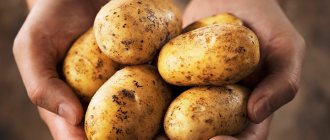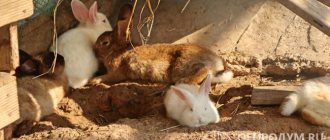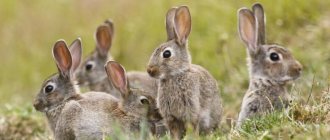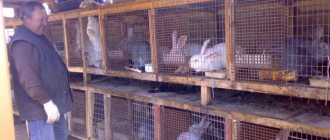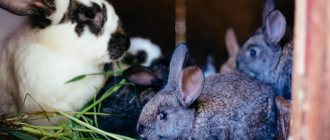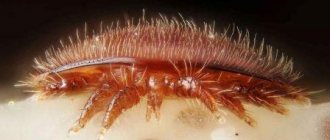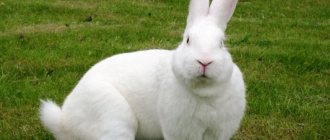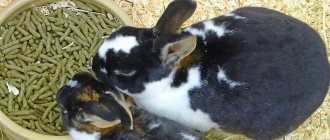May 4, 2012 Vladimir Khomyakov
Stomatitis is curable
The disease that I will talk about today, unfortunately, is not that uncommon on our farms. From time to time, among the herds you can find rabbits with wet faces - a consequence of exposure to a filter virus that causes stomatitis. And although this disease is not very dangerous, if you are careless, it can cause considerable damage to your business.
Statistics record average death rates of up to 30%, which you will agree is very alarming. The disease is seasonal, manifesting itself mainly in spring and autumn due to the fact that during these periods there are more young rabbits on farms.
of cases are young animals aged from 25 days to 3 months. Adults, as a rule, do not suffer, and those who recover receive lifelong immunity.
Another negative is that rabbits who have recovered from the disease cannot be left for posterity, as they are potentially dangerous and continue to be virus carriers. For commercial purposes, such animals are used without restrictions. The meat of recovered rabbits is suitable for consumption; the skins subsequently also gain the required condition.
FILTER VIRUS is a causative agent of infectious diseases, characterized by a very small size, mostly inaccessible to examination under a microscope, and passes through fine-porous (bacterial) filters. (Agricultural dictionary-reference book)
Signs and manifestations of stomatitis.
The first sign of infectious stomatitis is plaque in the mouth, tongue and upper lip, which changes color from white to gray-red as the disease progresses. This change in color of the affected areas occurs within 3 to 4 days and often goes unnoticed. Next, the resulting films peel off, under which relatively large ulcers are exposed, and salivation appears, which increases as the disease progresses. This is already the second sign of stomatitis. As a rule, this becomes a kind of signal to take emergency measures.
Due to the constant secretion of saliva, the muzzles and then the chests of the animals become wet. Ulcers can appear not only in the mouth, but also on constantly wet areas of the body. Attempts to wipe away excess moisture lead to nothing; phlegm appears again and again. Disheveled, emaciated, depressed animals huddle in the corner of the cage, often scratching their faces with their paws. Chewing movements are accompanied by characteristic slurping sounds.
At first, the disease does not affect the rabbits’ appetite in any way and this can mislead the owner. He will hope that everything will go away on its own and will miss the time to start treatment. However, as the disease progresses, due to painful sensations in the mouth, rabbits eat less and less, and as a result, noticeably lose weight. This in turn weakens the body, reduces immunity and it resists the virus less and less. Eventually, the rabbits refuse to eat at all, become completely exhausted and die of starvation. Before death, there is often indigestion, manifested in diarrhea. This phenomenon, as well as frequent changes in body temperature, are considered poor prognostic signs.
SALIVATION can also occur with other diseases. But there is one feature that prevents mistakes in diagnosing the disease. In cases of stomatitis, other clinical signs (depression, diarrhea, etc.) are characteristic, appearing after the onset of salivation, while in other diseases it is just the opposite. With heatstroke, drooling is also observed, but quickly disappears after the rabbits are moved to the shade or a cool place.
Symptoms
The disease develops quickly. The very first sign is the appearance of a specific plaque on the mucous membrane of the mouth and lips, which changes color as the disease progresses. In the first few days, it is quite difficult to detect if your pet is unwell. Subsequently, other symptoms appear, by which it is already possible to determine that the rabbit has a midge:
The rabbit doesn't eat well
- The muzzle becomes wet due to excessive salivation.
- Ulcers appear on the surface of the lips, tongue and cheek area.
- Further, the white dots increase in diameter and merge with each other.
- The rabbit has a wet chin and neck, the fur sticks together, and the skin in these places becomes inflamed. Later, pustules appear in these areas.
- The rabbit loses its appetite and it hurts to eat. Weight loss.
- The pet is depressed, sitting huddled in the corner of the cage.
- The temperature usually remains within normal limits.
The symptoms characteristic of different types of stomatitis are similar. However, a viral disease is often accompanied by diarrhea. This occurs due to the spread of ulcerative formations throughout the digestive tract, as well as due to intoxication.
Attention! It is necessary to distinguish the condition when the rabbit has a wet nose. This is a clear sign of rhinitis. At the same time, the pet’s fur on both its cheeks and chin becomes wet because it smears the mucus from its nose with its paw. With rhinitis, there are no ulcers or inflammation in the oral cavity.
Causes of the disease “wet face”.
The root cause of infectious stomatitis on your farm may be a sick rabbit. But often infection also occurs from a virus-carrying rabbit. We have already said that adult rabbits practically do not get sick, but they can carry a filtering virus in their bodies. Such a rabbit can easily be bought at the market or brought for mating, without even knowing about possible problems. In his body, the virus can hide in saliva, blood and urine. Most often, infections occur through contact with traces of the epithelium of the mucous membrane of the tongue - the site of localization of the virus. But the “wet muzzle” can also be brought in through grain and other feed contaminated by birds, rodents or insects.
If no positive dynamics are observed during the treatment of stomatitis or short-term improvements alternate with deterioration of the condition, most likely the cause is in the food. Try to analyze what new food you introduced during the period when stomatitis appeared. It is recommended to switch to new sources of feeding until the cause of the disease is determined. Cages and especially feeders with drinkers must be disinfected.
Prevention
To prevent wet faces in baby rabbits, you need to regularly carry out preventive measures:
- disinfection, disinfestation, deratization of the premises where the animals live;
- vaccination according to the vaccination schedule;
- feeding pets with vitamin supplements;
- add 1 teaspoon of iodine per 10 liters of water to the rabbits’ drink;
- animals that have recovered or are suspicious are kept in quarantine for two weeks, the same applies to newly arrived rabbits.
A wet muzzle in rabbits is one of the main signs of stomatitis, which is accompanied by profuse salivation. If you notice matted fur and a wet face, you should consult a veterinarian. In most cases, timely treatment significantly increases the chances of a favorable outcome for sick pets.
Forms of the disease and their consequences.
The disease can occur in both mild and severe forms. If left untreated, in mild cases, sick rabbits generally recover on the tenth to twelfth day from the onset of the disease of the oral mucosa or 8-10 days from the onset of drooling. In severe forms, mortality of individuals is likely; death occurs within 5 days. The ratio of mild to severe forms of the disease depends on the virulence (activity) of the virus. The disease is aggravated by overcrowding (violation of sanitary housing standards) of young animals, untimely cleaning of cages, insufficient feeding, during periods of sudden temperature changes, increased heat and humidity, when the immunity of animals decreases. What should you do first?
Rehabilitation of sick animals
Recovered animals can be kept in quarantine for about 30-40 days, and then transferred to a common cage or to the same room with other rabbits. Such animals will no longer become infected with stomatitis. They can be fed with regular food, and when they reach a certain age, they can be sent to slaughter. It is better not to use such animals for breeding. There is a possibility that the offspring may also develop stomatitis.
Measures for stomatitis and methods of its treatment.
First, immediately isolate sick rabbits from healthy ones and immediately disinfect cages and equipment. Next, be sure to treat everyone, even those rabbits that are healthy by all indications. The sooner you start treatment, the better the result will be. There are quite a few treatment methods, all of them are quite effective. Choose. which one suits you best:
- Wetting (irrigation) of the oral cavity with potassium permanganate (0.15% aqueous solution).
- Instillation of penicillin into the mouth (once a day, 0.05 - 0.1 g). Place a quarter of a tablet of white streptocide or crushed in your mouth for 2 to 3 days.
- Streptocidal ointment, which is a mixture of white streptocide and petroleum jelly, can be applied to the oral mucosa.
- Treatment of the affected areas with a swab soaked in a 2% aqueous solution of copper sulfate. Carry out the procedure twice a day until recovery.
If the rabbit is not very exhausted, after a couple or three days the disease recedes.
EXCELLENT HELP in the treatment of this disease. For example, 0.5 ml of Baytril can be poured into a rabbit’s mouth with a syringe, and everything goes away. By the way, the analogue of this drug “Enromag” (5% solution of enrofloxacin) costs half as much as Baytril. It is discussed in the following video:
It has been noted that decoctions of chamomile, oak bark, sage and calenula, which are anti-inflammatory drugs in their properties, work successfully both as a preventative against infectious stomatitis and as an auxiliary in its treatment. By the way, streptocide is often used for prevention, 0.1 g per day.
| Subscribe to our website's weekly newsletters: ✦ BROTHER RABBIT ✦ Current notes on keeping rabbits are waiting for you. SUBSCRIBE |
Veterinary clinics practice more radical methods of treatment - injections. A single injection of penicillin is administered subcutaneously at a dose of 20-40 thousand units or intramuscularly at a dose of 40 thousand units per 1 kg of rabbit weight. Here, the activity of penicillin is indicated in action units, which are applied to the ampoules. They also use homemade ointments, for example, with the following composition: 30 g of lanolin, 200 thousand units of penicillin, 2 g of sulfamide, 170 g of white neutral petroleum jelly.
The caloric intake of your sick pets should be improved. To enhance the effect of treatment, rabbit breeders sprinkle the feed with streptocide for two days or mix crushed tablets into it. A good friend of mine told me that he successfully cured his rabbit with Tricillin. Although this medicine is intended more for cows, its antimicrobial properties played a positive role.
Considering that it is painful for a rabbit to chew and swallow food, try to avoid feeding roughage. Use wet mash, and in particularly acute cases and complete refusal of feed, use a syringe with a nozzle for introducing liquid feed. These can include artificial mixtures for animals or infants, herbal decoctions and liquid porridges.
How to protect rabbits from biting midges
Measures to prevent the disease consist of preventing infection of livestock.
What do we have to do:
- regularly clean the rabbitry;
- disinfect equipment, cages and paddocks;
- avoid drafts and dampness in the impeller;
- comply with space standards for keeping animals;
- provide young animals and adults with varied and fresh food;
- carry out deworming of animals;
- conduct an inspection of the herd with a mandatory examination of the oral cavity;
- do not allow animals that have had the infection to reproduce.
As a preventive measure when weaning young animals from a female, it is recommended to feed the rabbits with an iodine solution, the composition is prepared in a proportion of 5 ml/10 l.
Non-traditional methods of treating “wet face”.
Employees of the Agrarian University of Moldova developed the drug Apidermin for use in the complex treatment of infected burn wounds, ulcers, and abscesses. Made from propolis, pollen and honey. In addition to those already listed, it has analgesic properties and stimulates the immune system. A valuable property of Apidermin is its anti-inflammatory effect, it increases the biological activity of connective tissue, accelerates regenerative processes in injured tissues.
Is it possible to give apples to rabbits and in what quantities, video and photos
Almost every novice breeder asks the question of whether it is possible to give apples to rabbits. Is this fruit useful for an eared friend, and in what quantity can it be added to the animal’s diet? And also what kind of apples are allowed?
What types of apples can you give?
In our country, these fruits ripen closer to August. Therefore, it is recommended to give this fruit to rabbits starting from this time of year. At the same time, keep in mind that July unripe fruits should not be given to the animal. The fact is that if a rabbit eats an unripe apple, there is a high probability that the animal will get an intestinal disorder.
For rabbit food, it is best to give fruits that ripen in your region of residence or in the south of Russia. As for fruits that can be purchased at any time of the year in the store, you should refuse to buy such apples.
The fact is that they contain a lot of different chemicals that increase the shelf life of the fruit and its external qualities. It is best to exchange imported fruits for homemade vegetables or special food that contains iron. Do not forget that foreign apples are dangerous not only for animals; it is better not to eat such fruits yourself.
Before giving a homemade apple to your rabbit, make sure there are no signs of rot or other defects. They can taste either sour or sweet, and in this case there is no difference, the main thing is that the animal eats them. At the same time, do not forget that before giving a treat to your long-eared pet, thoroughly rinse the apple tree fruit and dry it.
Another point that you need to pay attention to is that if you treated the wood with chemicals, then before giving the fruit to the animal, pour boiling water over it. And, of course, do not forget to cut the fruit and remove all the seeds from it for the convenience of the eared
Well, if you like to prepare apple juice for the winter, then feel free to send the squeezed pulp to the animal’s feeder
And, of course, do not forget to cut the fruit and remove all the seeds from it for the convenience of the eared one. Well, if you like to prepare apple juice for the winter, then feel free to send the squeezed pulp to the animal’s feeder.
How many apples can an eared one
So, above we considered the following question: can you feed rabbits apples?
Another point that is very important to consider is how much this fruit can be given to rabbits. First of all, it is worth emphasizing that it is necessary to feed rabbits in moderation.
This applies to absolutely all products.
If you feed food in large quantities, the animal may experience an upset stomach. Well, as for apples, they are gradually being introduced into the daily diet. Rabbits are fed these fruits according to the following scheme:
- on the first day they give 1/4 of the fruit;
- then, a break is taken for several days to track the reaction of the big-eared one to the eaten fruit; if everything is fine, then for the first week they give a slice of apple every day;
- starting next week, the animal will be given half a piece of fruit per day; They feed this way for another week, while monitoring the animal’s well-being;
- and starting from the third week, the eared pet is given a whole fruit as food, but every other day.
At the same time, do not forget that if you gave the rabbit an apple during the day, then it is better to give green grass in the evening. You should not feed green matter and fruits at the same time, so as not to provoke intestinal upset in the animal. Do not forget that such a defect is very dangerous for the eared one.
Another question that novice rabbit breeders ask is whether rabbits can be given pears.
P.S.
In conclusion, I would like to remind you once again that attacks of viral stomatitis become more frequent when young rabbits appear on your farm; they are especially intensified during periods of stress, as the immune system noticeably weakens. For example, in extreme heat, a period of prolonged rains leading to increased air humidity, or, conversely, prolonged drought and stuffiness. And temperature changes have a negative impact on the general condition of rabbits. If we add to this periods of stress from possible transportation, moving from cage to cage, changing feeding from mother's milk to regular food, drinking, deworming and banal fights, then it would not be superfluous to once again check the rabbit's tongue, take a closer look to see if he is salivating , is your face wet? That's all. I hope that thanks to this article, you have learned something useful for yourself and will not let viral infectious stomatitis run rampant in your household.
Please share this article with your friends on social networks:
Please rate the article. Ask a question, discuss on the forum.
Preparing plant materials for the winter
In spring and summer, birds get a lot of vitamins from greens and vegetables from the garden. In winter, poultry's immunity weakens. To support it, you need to harvest forbs for future use. Plants are harvested in the spring, when they contain the most useful substances.
The collected stems and leaves are laid out in a thin layer in the shade under a canopy, covered with a layer of gauze and dried for several days. The blanks are placed in canvas or paper bags and stored in a dry, well-ventilated place. In winter, dried greens, including dandelions, are added to wet mash.
Dried dandelions for chickens
Features of feeding
In any case, it is necessary to follow a well-constructed scheme for caring for animals, provide them with proper living conditions and be prepared to feed the livestock.
Under natural conditions, rabbits obtain their food by grazing in meadows. The gastrointestinal tract of these animals is adapted for the constant process of digestion. In the absence of nutritious food and fresh grass, individuals begin to lose weight and become ill. In this regard, when keeping rabbits, the basis of their diet should be a variety of fresh, juicy herbs. It is best to use wild herbs instead of store-bought mixes.
The optimal diet consists of the following herbs: burdock, clover and dandelion. However, you should be careful with some types of plants. For example, you can safely give only young shoots of quinoa and in small quantities. Increasing the percentage of quinoa in the diet can lead to hyperdevelopment of intestinal microflora, which will lead to bloating and disruption of digestive processes.
Currently, there is conflicting evidence about the possibility of including some wild herbs in the diet. One of them is milkweed.
Feeding milkweed to rabbits
Euphorbia, or Euphorbia, belongs to one of the most numerous genera of the plant world. It has over 2000 plant species. Among them there are both herbaceous forms, shrubs and trees. Approximately 160 species are distributed on the territory of the Russian Federation.
Poisonous herbs
It is noted that even harmful plants, if they are withered and dried, partially lose their toxic properties. Therefore, if some herbs are found among the forbs in a new place, the food should be given not fresh, but after drying.
Definitely, in any form, you should not give the following grass to rabbits:
- common datura;
- poisonous buttercup;
- belladonna;
- horned cornflower;
- white hellebore and Lobel's hellebore;
- intoxicating tares;
- ambrosia.
Poisonous grass for rabbits also includes:
- common thorn;
- vekh poisonous;
- black henbane;
- nightshade;
- raven eye;
- cockle;
- spotted arum.
Poisonous plants for rabbits can be:
- anemone;
- Ivan-da-Marya;
- swamp whitewing;
- autumn colchicum;
- wrestler (wolfsbane);
- marsh marigold;
- larkspur.
Rabbits should not be given potato tops and some plants considered medicinal, for example, hemlock, celandine, auranium officinalis, foxglove, lily of the valley, poppy and St. John's wort, horsetail. Even in small quantities they can cause poisoning, disruption of many organs, paralysis and death of animals.
Useful properties of yarrow
Yarrow tastes good, so rabbits eat it with pleasure. This plant is a medicinal plant and is beneficial for furry pets. The herb contains:
- Bitterness.
- Resinous substances.
- Essential oil.
- Organic acids.
- Tannins.
- Flavonoids.
- Coumarins.
The vitamins present in the green part of the plant are ascorbic acid, K (the so-called antihemorrhagic vitamin), and carotene. All of them are extremely useful for rabbits - carotene is especially necessary for young animals for normal development and growth. Ascorbic acid strengthens the immune system of animals, and vitamin K helps normalize the process of blood clotting.
The tannins in yarrow have astringent properties. They help fight intestinal upset. The introduction of this herb into the diet of rabbits has a beneficial effect on their appetite. The animals' intestines work better and gases do not accumulate in them.
Yarrow prevents helminth infection
Yarrow prevents infection by helminths, has an anti-inflammatory effect, accelerates metabolic processes, and removes harmful substances from the body of animals.
Attention! To prevent constipation in rabbits, it is advisable to give them yarrow mixed with herbs that have a laxative effect.
What should not be in the diet: prohibited foods
Due to their undeveloped stomach muscles and very long intestines, rabbits must always be provided with sufficient food. Each new portion of food pushes what was previously eaten through the intestines. To avoid stagnation, the rabbit must constantly eat something. However, it is also impossible to overfeed animals, and if there is often food left in the feeders, then the amount of food consumed should be reduced.
Not all grass is good for rabbits.
Rabbits have a very fast metabolism, so they eat a lot. But not every food is healthy. There are some foods that can be extremely dangerous for them. So what should you not feed rabbits? Let's try to figure it out.
Vegetables and fruits
Rabbits love succulent food, which includes vegetables and fruits. But they should not make up more than a third of the total daily diet. An excess of such feed can lead to bloating, disruption of the stomach and intestines, and in some cases, the death of the animal.
Be careful when feeding rabbits dried vegetables in winter. They swell in the stomach, which can lead to intestinal blockage.
Do not give boiled, fried or stewed vegetables to rabbits.
As for fruits, the choice is small. Rabbits can only be offered dried apples and pears, in small quantities and not often. Moreover, it is better to dry them yourself, after removing the core. Under no circumstances should rabbits be fed any exotic fruits.
You should not give fresh berries to rabbits, they cause fermentation in the intestines.
Plants
The rabbit's diet should contain three types of green food: medicinal herbs, meadow herbs and garden herbs. Freshly cut, wet grass should not be given. Eating wet grass can cause bloating and diarrhea. To avoid unpleasant consequences, it must be well dried and slightly wilted. To do this, fresh grass is left for several hours in a shady, well-ventilated place. If you cut the grass in dry weather, without dew or rain, then you can do without drying
It is important to know what grass you should not feed rabbits
Branches that are so necessary for healthy teeth and stomach must also be chosen with care. Animals should not be given branches of wild rosemary, apricot, bird cherry, wolf's bast and elderberry.
Limit the consumption of cherry and cherry branches.
Poisonous and dangerous plants:
- horse sorrel;
- aconite;
- quinoa;
- spurge;
- Melissa;
- wild radish;
- digitalis;
- lily of the valley;
- marsh horsetail;
- buttercup;
- sleep-grass;
- celandine;
- henbane;
- nightshade;
- hellebore;
- hemlock;
- lumbago;
- dope.
Milk products
Contrary to popular belief that milk protein is good for animals, this is not the case with rabbits. Only suckling babies need milk before and after vaccination. And for adult rabbits, milk, sour cream, cottage cheese and cheese are prohibited. Protein deficiency can be easily compensated with barley and dry yellow peas (in small quantities).
Sweets in the diet of rabbits: what is possible and what is not
What to feed your rabbit to make him happy? How to reward your pet? Give him pleasure?
First of all, forget about all the sweets that you eat yourself. No sweets, biscuits, cakes, chocolate. All this is not very useful for humans, let alone decorative rabbits?
However, dwarf rabbits have a terrible sweet tooth. They are ready to beg for chocolate and candy for hours. What to do? What treats are acceptable as rabbit food?
Some owners make the mistake of starting to buy treats at a pet store. I'm talking about drops, baskets and so on. All this is pure chemistry. Just look at the composition once. There's sugar, honey, and even eggs!
Therefore, secondly, forget about such attractive, but no less dangerous industrial delicacies.
You can give: raisins (several pieces per week) or dried apricots. Better yet, buy a bag of dried fruit from the zoo. There are also bananas, which rabbits love.
However, you can give bananas anyway, just be careful - a small piece once a week
And also treat your pet with a sweet carrot or an apple - that’s the best solution :). This way your baby will indulge in sweets without ruining his health.
Of course, the topic of “what to feed rabbits” has not yet been exhausted. We have a lot to discuss ahead—meat, mushrooms, cheese, and bread. But everything is gradual.
The health and fertility of rabbits, like any animal, depends not only on the correct creation of living conditions, but also on a well-thought-out diet. Experienced breeders know that not all recommendations voiced by professors are applicable for a particular family of long-eared animals. Therefore, you need not only to adhere to the advice received, but also to monitor the condition of the livestock. So, for example, if one rabbit eats a green salad with pleasure, then another may get a little food poisoning. Then the question arises: “Can rabbits eat salad?”
What can you give a rabbit?
How to choose the right food, rich in minerals and not capable of harming the delicate body of long-eared animals? You will find the answer to this question in the presented review.
